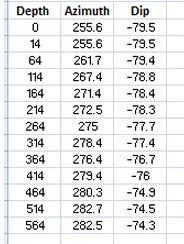针对500米深的钻孔,您可以使用最小曲率法,否则位置误差将非常大。我在地质统计的Python模块(PyGSLIB)中实现了这一点。以下是一个示例,展示了真实钻孔数据库的完整测量过程,包括试金石/岩性间隔的位置:
http://nbviewer.ipython.org/github/opengeostat/pygslib/blob/master/pygslib/Ipython_templates/demo_1.ipynb
这还展示了如何将钻孔以VTK格式导出以便在Paraview中加载。
在Paraview中显示的结果
Cython代码来desurvey一个间隔如下:
cpdef dsmincurb( float len12,
float azm1,
float dip1,
float azm2,
float dip2):
"""
dsmincurb(len12, azm1, dip1, azm2, dip2)
Desurvey one interval with minimum curvature
Given a line with length ``len12`` and endpoints p1,p2 with
direction angles ``azm1, dip1, azm2, dip2``, this function returns
the differences in coordinate ``dz,dn,de`` of p2, assuming
p1 with coordinates (0,0,0)
Parameters
----------
len12, azm1, dip1, azm2, dip2: float
len12 is the length between a point 1 and a point 2.
azm1, dip1, azm2, dip2 are direction angles azimuth, with 0 or
360 pointing north and dip angles measured from horizontal
surface positive downward. All these angles are in degrees.
Returns
-------
out : tuple of floats, ``(dz,dn,de)``
Differences in elevation, north coordinate (or y) and
east coordinate (or x) in an Euclidean coordinate system.
See Also
--------
ang2cart,
Notes
-----
The equations were derived from the paper:
http://www.cgg.com/data//1/rec_docs/2269_MinimumCurvatureWellPaths.pdf
The minimum curvature is a weighted mean based on the
dog-leg (dl) value and a Ratio Factor (rf = 2*tan(dl/2)/dl )
if dl is zero we assign rf = 1, which is equivalent to balanced
tangential desurvey method. The dog-leg is zero if the direction
angles at the endpoints of the desurvey intervals are equal.
Example
--------
>>> dsmincurb(len12=10, azm1=45, dip1=75, azm2=90, dip2=20)
(7.207193374633789, 1.0084573030471802, 6.186459064483643)
"""
# output
cdef:
float dz
float dn
float de
# internal
cdef:
float i1
float a1
float i2
float a2
float DEG2RAD
float rf
float dl
DEG2RAD=3.141592654/180.0
i1 = (90 - dip1) * DEG2RAD
a1 = azm1 * DEG2RAD
i2 = (90 - dip2) * DEG2RAD
a2 = azm2 * DEG2RAD
# calculate the dog-leg (dl) and the Ratio Factor (rf)
dl = acos(cos(i2-i1)-sin(i1)*sin(i2)*(1-cos(a2-a1)))
if dl!=0.:
rf = 2*tan(dl/2)/dl # minimum curvature
else:
rf=1 # balanced tangential
dz = 0.5*len12*(cos(i1)+cos(i2))*rf
dn = 0.5*len12*(sin(i1)*cos(a1)+sin(i2)*cos(a2))*rf
de = 0.5*len12*(sin(i1)*sin(a1)+sin(i2)*sin(a2))*rf
return dz,dn,de
